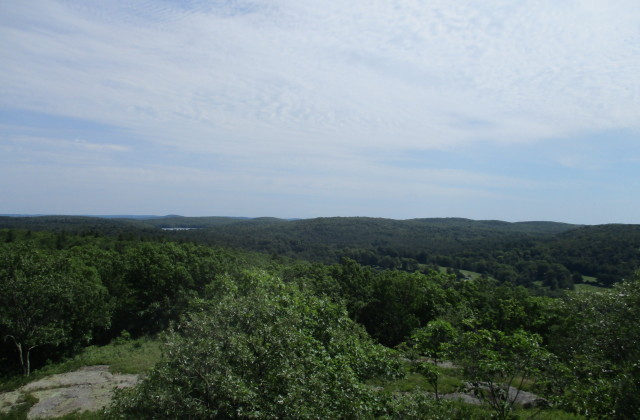It’s Only Natural—A Walk Up Stoneman
Merging ecology and history
By Hans M. Carlson
A black squirrel runs across Canaan Mountain Road as I walk north toward the intersection of Steep Road and toward the Iron Trail up Canaan Mountain. I see this squirrel regularly, just north of the Great Mountain Forest (GMF) offices, and it always surprises me a little. When I lived in Ottawa fifteen years ago, there were black squirrels everywhere but this is the only one I’ve ever seen in New England. There are only small populations of this subgroup of gray squirrels here in Connecticut.
This is ecologically interesting, because black squirrels are a distinct melanistic variety, not genetic anomalies, so I am likely seeing more than the one. It’s also interesting because black squirrels appear to have dominated throughout North America, before European arrival, in the old-growth forests where their black coats concealed them better in the dense shade. Deforestation led to biological disadvantages for them, and better conditions for grays. Today, black squirrels are still abundant, but in northern regions where their black fur allows them to absorb more of the sun’s heat and they still have an advantage in denser northern forests.
As with everything in our forest, this marks a confluence of history and ecology. Our 19-acre clear-cut for New England cottontail habitat, just east of the road here, is a perfect example. It is late afternoon, so little is going on in there now, but it has become a popular place for songbirds, deer, and grouse, as well as rabbits. There is a very distinctive red-shouldered hawk, with missing flight feathers, who likes it, too.
In one sense this new activity is an example of human action and natural reaction. Yet we cut this land in part because young forest habitat is on the decline in Connecticut, as trees regrow and parts of the state become more urban. The cut is really part of an ongoing dialogue of people and land. Deforestation in the nineteenth century was many orders of magnitude greater than our tiny rabbit cut, but they are connected.
I turn south onto the GMF Iron Trail near the corner. The trail crosses regrown fields that were once part of the Root farm, now regrown in pine and mixed hardwoods. Farmers cut a lot of trees, but it was for charcoal making that people cut most of this forest. Our trail is the southern half of a longer path between the cairn called “Stoneman,” at the summit, and Beckley Furnace, down in Canaan. It connects that remnant of the early iron industry with the mountain view of this post-industrial landscape.
After the old fields, the trail crosses a branch of Wangum Brook, then starts the climb. Part follows an old road, and many current red trail-markings are painted over old axe blazes. Sam Hawley kept the path open when he lived on the mountain, but parts have been used since the charcoaling days. There are several old hearths along the trail, and more in the woods, I’m sure.
On Canaan Mountain, the view is in two directions, and the best is back over GMF and Wangum Lake to the north. Beyond Rustling Winds Stable, the forest appears unbroken toward Norfolk. In a region of highly fragmented forestland, a century of private and public conservation has also reshaped the forest—nature’s response to the decision to treat woodlands with more care. The forest is vastly different now, but amazingly intact.
The view west over the Housatonic Valley is more obscured by trees, but you can see the quarries below, the various farms and houses and the line of Route 7—a whole host of past and present uses, inscribing history on the land. When the leaves are down, you can also see Robbins Swamp, filling the heart of Falls Village. Seven or eight thousand years ago, Native Americans living there began that historical dialogue between people and land in this region.
The temptation is to contrast the views east and west—one natural and the other cultural—but they are in fact like the rarity of black squirrels in our forest—historical variations on the call and response between human cultures and the ecology of the northwest corner.
Photo by Hans M. Carlson.

